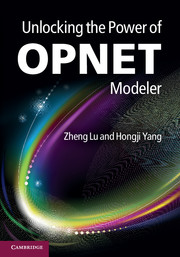Book contents
- Frontmatter
- Contents
- Preface
- List of abbreviations
- Part I Preparation for OPNET Modeling
- 1 Introduction
- 2 Installation of OPNET Modeler and setting up environments
- 3 OPNET Modeler user interface
- Part II Modeling Custom Networks and Protocols
- Part III Modeling and Modifying Standard Networks and Protocols
- Part IV OPNET Modeling Facilities
- References
- Index
1 - Introduction
from Part I - Preparation for OPNET Modeling
Published online by Cambridge University Press: 05 February 2012
- Frontmatter
- Contents
- Preface
- List of abbreviations
- Part I Preparation for OPNET Modeling
- 1 Introduction
- 2 Installation of OPNET Modeler and setting up environments
- 3 OPNET Modeler user interface
- Part II Modeling Custom Networks and Protocols
- Part III Modeling and Modifying Standard Networks and Protocols
- Part IV OPNET Modeling Facilities
- References
- Index
Summary
This chapter introduces network modeling and simulation, and both OPNET and OPNET Modeler. If you already have relevant background, you can quickly read through this chapter and go to Chapter 2.
Network modeling and simulation
There are several feasible methods for investigating networking protocols and evaluating network performance (Leemis and Park 2006; www.opnet.com):
Analysis and mathematical modeling
Simulation – typically time-based simulation or discrete event-based simulation
Hybrid simulation with both analysis and simulation
Test-bed emulation
Analysis and mathematical modeling can provide quick insights and answers to the problems being studied. It is generally faster than simulation, but in many cases is inaccurate or inapplicable. Analytical models are not available for many situations. Even so, many of the available models lack accuracy and some are modeled through approximations. Especially for a network of queues, it can either be decomposed via the Kleinrock independence assumption or be solved using a hop-by-hop single system analysis, both of which lose accuracy. The modeling difficulties and loss of accuracy can be greatly exacerbated when the networking protocols become even slightly complex. It is often necessary to resort to approximation by reducing the general model to a typical and representative analytical path in order to reduce the analytical difficulties (Kleinrock, 1976).
Network simulation provides a way to model the network behaviors by calculating the interactions between modeling devices. Discrete event simulation (DES) is the typical method in large-scale simulation studies instead of a simpler time-based method.
Information
- Type
- Chapter
- Information
- Unlocking the Power of OPNET Modeler , pp. 3 - 10Publisher: Cambridge University PressPrint publication year: 2012
